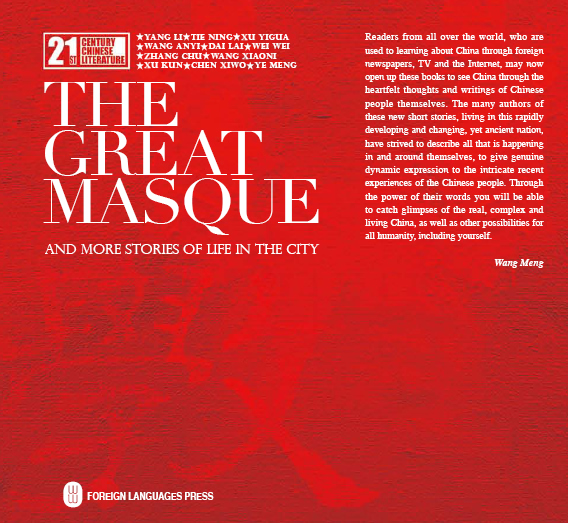A must for summer reading lists, don't miss Foreign Languages Press' (FLP, Beijing) exciting new series of contemporary fiction, "21st Century Chinese Literature," launched with 3 collections of short stories and novellas from 30 most-loved writers, many translated for the first time into English.

How Far Is Forever: 11 Women's stories mirror changes in women's lives through diverse styles of prose distinct in their exquisite and attentive language. The well-known (and sometimes controversial) writers include Fang Fang, Chi Li and Wei Wei.
The Great Masque: 11 stories on life in China's rapidly changing Cities, under an earth-shaking rural-urban shift. This book includes award-winning writers Tie Ning, Wang Anyi, Dai Lai and Chen Xiwo.
Plum Raindrops: 11 tales on the tumult of Youth; times and settings differ, yet the characters share a common idealism and imagination, growing up midst painful challenges and inimitable emotions. The New Generation or 1980s-born authors provide vivid and fresh coming-of-age stories.
Most stories were translated by Chinese scholars living in North America.
This new literature opens windows into China of the fresh hopes, hard realities as well as sweeter subtleties of people's lives over the last few decades. Many of the stories may surprise with their honest candor and vivid detail on new ways of life, sexuality, inequality (rural-urban, women-men) and contradictions. Readers everywhere, curious to learn more about China, will appreciate the ranging tales: from rollicking quests for cyber-love and modern murder mysteries, to get-rich-quick sage sagas and poignant revelations.
For book orders in China, visit FLP website:
http://www.flp.com.cn/en/bookc2.cfm?sCid=EN04&sModule=Literature
In North America go to Chinabooks.com in San Francisco (for Australia: http://www.chinabooks.com.au/ChinaBooks/)
See also, Chinese literature website by FLP (with many full story excerpts): http://219.216.192.3/englishonline/culture/chineseculture/chineseliterature/col.htm
From editor's Introduction to City stories:
"At the beginning of the 21st century, Chinese fictionists have discerned the tremendous difficulty in assigning identity to a person... in a modern city emerging on a colossal scale, including the internet, mass media, a maze of roads and buildings, lavish material wealth... There are no strangers in villages, whereas strangers are everywhere in an open, fluid modern city. ... It is based upon this difficulty that contemporary literary writers have developed a complex, subtle narrative art.
This, probably the largest human migration ever in modern history, was accompanied by the decline of urban work-unit systems and the collapse of the public housing distribution system. The urban areas became open, fluid and jumbled spaces. Disordered yet splendid modern cities appeared for the first time..., within a relatively short span of time, often quite overwhelming in its force."
Chinese fiction writers have been focusing their gaze on...a clamorous, diversified world full of relentless streams of overlapping illusions. The difficulties facing them are attentively and accurately described in "Last Tango in a Square during a Midsummer Night," by Xu Kun:
"Sometimes the other dancers cannot help but try to stealthily imitate some of their moves. They not only start to stride over some basic 'Beijing 4-step dances' following them, but also try one or two poses from their 'Argentine Tangos.' However, the latter is so difficult that people find it hard to make such wild poses. A man can get a crick in his neck if he turns his head too fast, or a woman may hear her knee crack when she kicks a little too high. Hence people sigh inwardly: not all the middle-aged and elderly can deal with the Tango – a type of expertise that makes an issue out of the female body. Feeling gradually convinced, with a secret admiration brewing for the pair, the dancers in the square begin to feel attracted by the duo. While dancing, their feet uncontrollably drag them towards the two in their center.
The man and the woman seem to sense nothing around them but just dance attentively within their own small radius of activity. The duo's dancing become more and more advanced as the square becomes their public stage to trot out their techniques. Their bodies get closer, their shoulders rub more intimately and their hips swing even more dramatically. Given to abandon yet at the same time ambiguous, they dance together by touching and caressing, enjoying each other through their mutual plunging; their bodies in communication where the public eye doesn't detect. Surrounded by approving sighs and the admiring looks of the onlookers, they soar higher, burning and blossoming boundlessly. They are simply uninhibited and bursting free. ... Their desire spurting, their bodies join each other into one."